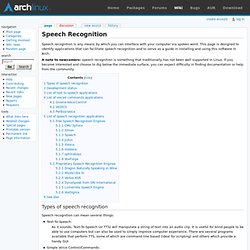

How to Add Speech Recognition to your Website with HTML. Learn how to enable speech recognition in your website using the HTML5 web speech API.

Your website website will be able to fill textareas and input form fields using their voice. Open the Google website on your desktop computer and you’ll find a little microphone icon embedded inside the search box. Click the icon, say something and your voice is quickly transcribed into words. Unlike earlier speech recognition products, you no longer have to train the browser to understand your speech and, for those who don’t know touch typing, speech is often a faster mode of input than the keyboard.
Sounds like magic, right? Before we dive into the actual implementation, let’s play with a working demo. The HTML5 Web Speech API has been around for few years now but it takes slightly more work now to include it in your website. Earlier, you could add the attribute x-webkit-speech to any form input field and it would become voice capable. Some notes: Dictation - Online Speech Recognition. Speech recognition software for Linux. There are currently several speech recognition software packages for Linux, some of them being open-source and others proprietary.

Native Linux speech recognition[edit] History[edit] In the late 1990s, a Linux version of ViaVoice (created by IBM) was made available to users for no charge. However, the free SDK was removed by the developer in 2002. Current development status[edit] Recently, there has been a push to get a high-quality native Linux speech recognition engine developed. SpeechRecognition concept[edit] The first step starts recording an audio stream on the linux machine. Process the voice recognition on his local machine orsubmit the audio file to a remote server for converting the audio file into a text string. The second option, OpenMoko Speech Recognition, is used mainly on smartphones, because they do not have the performance and disk space to process the speech recognition on the phone. List of speech recognition software. Open source acoustic models and speech corpus[edit] The following list presents notable speech recognition software with a brief synopsis of characteristics.

Macintosh[edit] Mobile Devices / Smartphones[edit] Many cell phone handsets have basic dial-by-voice features built in. Smartphones such as iPhone or Blackberry also support this. Speech Recognition. Speech recognition is any means by which you can interface with your computer via spoken word.

This page is designed to identify applications that can facilitate speech recognition and to serve as a guide in installing and using this software in Arch. A note to newcomers: speech recognition is something that traditionally has not been well supported in Linux. If you become interested and choose to dig below the immediate surface, you can expect difficulty in finding documentation or help from the community. Raspberry Pi Voice Recognition Works Like Siri.
This tutorial demonstrate how to use voice recognition on the Raspberry Pi.

By the end of this demonstration, we should have a working application that understand and answers your oral question. This is going to be a simple and easy project because we have a few free API available for all the goals we want to achieve. It basically converts our spoken question into to text, process the query and return the answer, and finally turn the answer from text to speech. I will divide this demonstration into four parts: speech to textquery processingtext to speechPutting Them Together Result Example: This has been a very popular topic since Raspberry Pi came out.
You can use an USB Microphone, but I don’t have one so I am using the built-in Mic on my webcam. Of course, the Raspberry Pi as well. You will also need to have internet connection on your Raspberry Pi. sudo apt-get install ffmpeg To use the Google’s voice recognition API, I use the following bash script. Voice controlling your home w/ Raspberry Pi.
In this post we will be controlling 433 MHz light switches using a ready to use voice controlling software and a modified fork of a 433 MHz transmitter software on the Raspberry Pi.

Basically I used a ready to use voice controlling software called Voicecommand, which you can assign keywords and commands and assign what the software will do when heard those commands. In this case I assigned shell scripts to the command-words which executed the 433 Mhz send command, gave voice feedback to what exactly it did and also sent a notification to XBMC which pops up on the top of the monitor to also notify you what it did.
To use the 433 Mhz transmitter I needed a 433 Mhz transmitter library or software, or else this would take too long to get ready. I found something called RCSwitch-Pi which seemed like a good program. Unfortunately I didn’t get it to work with my specific switches, so I modified the source code to make it work to my needs. Apt-get update apt-get install git -y cd ~/ git clone.